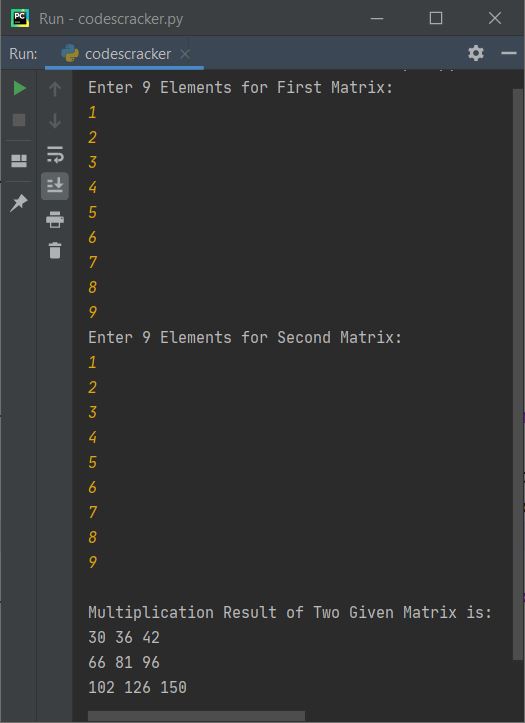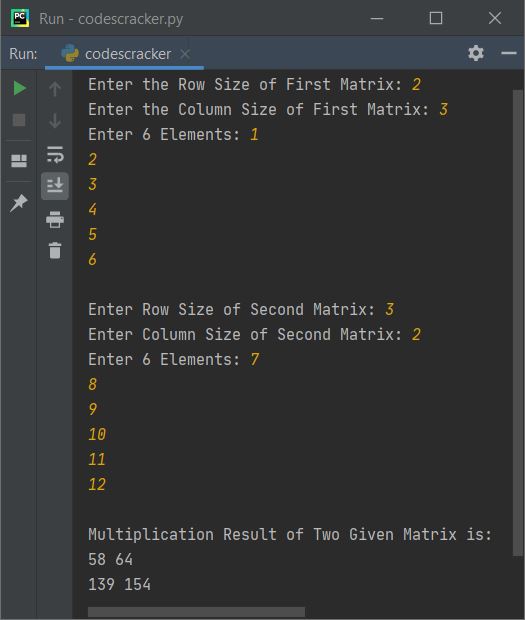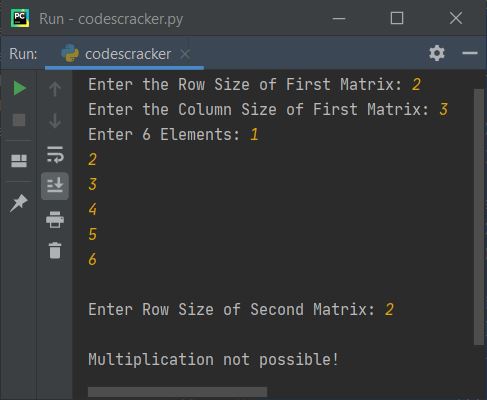- Python Basic Programs
- Python Program Examples
- Python Print Hello World
- Python Get Input from User
- Python Add Two Numbers
- Add Subtract Multiply Divide
- Python Check Even or Odd
- Python Check Prime or Not
- Python Check Alphabet or Not
- Python Check Vowel or Not
- Python Check Leap Year or Not
- Check Reverse equal Original
- Check Positive Negative Zero
- Python Check Armstrong or Not
- Python Check Palindrome or Not
- Python Check Perfect Number
- Python Find Reverse of Number
- Python Count Digits in Number
- Python Add Digits of Number
- Sum of First and Last Digits
- Python Product of Mid Digits
- Sum of Squares of Digits
- Interchange Digits of Number
- Python Sum of n Numbers
- Python Print ASCII Values
- Python Swap Two Numbers
- Python Swap Two Variables
- Python Fahrenheit to Celsius
- Python Celsius to Fahrenheit
- Python Display Calendar
- Python Days into Years, Weeks
- Find Largest of Two Number
- Find Largest of Three Number
- Python Print Fibonacci Series
- Generate Armstrong Numbers
- Python Make Simple Calculator
- Python Add Binary Numbers
- Binary Number Multiplication
- Python Mathematical Programs
- Find Sum of Natural Numbers
- Find Average of n Numbers
- Python Print Multiplication Table
- Print Table using Recursion
- Python Find Average Percentage
- Python Find Grade of Student
- Find Square Root of Number
- Python Print Prime Numbers
- Find Numbers Divisible by
- Python Find Factors of Number
- Python Find Factorial of a Number
- Python Find HCF & LCM
- Python Kilometres to Miles
- Python Find Area of Square
- Python Find Area of Rectangle
- Python Find Area of Triangle
- Python Find Area of Circle
- Python Find Perimeter of Square
- Find Perimeter of Rectangle
- Python Find Perimeter of Triangle
- Find Circumference of Circle
- Python Simple Interest
- Python Solve Quadratic Equation
- Python Different Set of Operations
- Python Display Powers of 2
- Python Find nCr & nPr
- Python Pattern Programs
- Python Print Pattern Programs
- Python Print Diamond Pattern
- Python Print Floyd's Triangle
- Python Print Pascal's Triangle
- Python List Programs
- Python Count Even/Odd in List
- Python Positive/Negative in List
- Python Even Numbers in List
- Python Odd Numbers in List
- Python Sum of Elements in List
- Sum of Odd/Even Numbers
- Python Element at Even Position
- Python Element at Odd Position
- Python Search Element in List
- Python Largest Number in List
- Python Smallest Number in List
- Python Second Largest in List
- Python Second Smallest in List
- Python Insert Element in List
- Python Delete Element from List
- Python Multiply Numbers in List
- Swap Two Elements in List
- Python 1D Array Program
- Python Linear Search
- Python Binary Search
- Python Insertion Sort
- Python Bubble Sort
- Python Selection Sort
- Remove Duplicates from List
- Python Reverse a List
- Python Merge Two List
- Python Copy a List
- Python Conversion Programs
- Python Decimal to Binary
- Python Decimal to Octal
- Python Decimal to Hexadecimal
- Python Binary to Decimal
- Python Binary to Octal
- Python Binary to Hexadecimal
- Python Octal to Decimal
- Python Octal to Binary
- Python Octal to Hexadecimal
- Python Hexadecimal to Decimal
- Python Hexadecimal to Binary
- Python Hexadecimal to Octal
- Python Matrix Programs
- Python Add Two Matrices
- Python Subtract Two Matrices
- Python Transpose Matrix
- Python Multiply Matrices
- Python String Programs
- Python Print String
- Python Find Length of String
- Python Compare Two Strings
- Python Copy String
- Python Concatenate String
- Python Reverse a String
- Python Swap Two Strings
- Python Uppercase to Lowercase
- Python Lowercase to Uppercase
- Python Check Substring in String
- Python Count Character in String
- Count Repeated Characters
- Python Count Word in Sentence
- Python Count Each Vowels
- Python Capitalize Character
- Python Capitalize Word in String
- Python Smallest/Largest Word
- Remove Spaces from String
- Remove Duplicate Character
- Remove Vowels from String
- Remove Punctuation from String
- Python Remove Word in String
- Python Remove Duplicate Words
- WhiteSpace to Hyphens
- Replace Vowels with Character
- Replace Character in String
- Python Sort String in Alphabetical
- Sort Word in Alphabetical Order
- Extract Number from String
- Python Check Anagram Strings
- Python File Programs
- Python Read a File
- Python Write to File
- Python Append Text to File
- Python Copy Files
- Python Merge Two Files
- Python Counts Characters in File
- Python Count Words in File
- Python File Content in Reverse
- Python Lines Contains String
- Python Delete Line from File
- Python Capitalize Word in File
- Python Replace Text in File
- Replace Specific Line in File
- Python Find Size of File
- Python List Files in Directory
- Python Delete Files
- Python Misc Programs
- Python Reverse a Tuple
- Python Merge Two Dictionary
- Python bytes to String
- Python bytearray to String
- Generate Random Numbers
- Python Print Address of Variable
- Python Print Date and Time
- Python Get IP Address
- Python Shutdown/Restart PC
- Python Tutorial
- Python Tutorial
Python Program to Multiply Two Matrices
This article is created to cover some programs in Python, that performs matrix multiplication. Here are the list of programs:
- Multiply Two 3*3 Matrices entered by user
- Multiply Two Matrices of Given Size and Elements, by user at run-time
Before creating these programs, if you're not aware about steps used to define matrix multiplication, then refer to Matrix Multiplication Steps and Example to get every required thing about the topic. Now let's move on and create a Python program to implement matrix multiplication.
Multiply Two 3*3 Matrices entered by User
To perform matrix multiplication or to multiply two matrices in Python, you have to ask from user to enter 9-9 elements for both matrices one by one. Then perform the operation of matrix multiplication and print the result like shown in the program given below:
matOne = [] print("Enter 9 Elements for First Matrix: ") for i in range(3): matOne.append([]) for j in range(3): num = int(input()) matOne[i].append(num) matTwo = [] print("Enter 9 Elements for Second Matrix: ") for i in range(3): matTwo.append([]) for j in range(3): num = int(input()) matTwo[i].append(num) matThree = [] for i in range(3): matThree.append([]) for j in range(3): sum = 0 for k in range(3): sum = sum + (matOne[i][k] * matTwo[k][j]) matThree[i].append(sum) print("\nMultiplication Result of Two Given Matrix is:") for i in range(3): for j in range(3): print(matThree[i][j], end=" ") print()
Here is its sample run:

Now supply the input say 1, 2, 3, 4, 5, 6, 7, 8, 9 as nine elements for first and then same nine elements for second matrix to perform the multiplication and print the multiplication result like shown in this snapshot given below:

From above program, the following statement:
matOne = []
defines an empty list named matOne. And the following statement:
matOne.append([])
appends an empty list as an element. This statement is used to store all 9 elements to list matOne in 3-3 pairs. That is, following statements:
matOne = []
matOne.append([])
indicates to:
matOne[[]]
Therefore after entering all nine (say 1, 2, 3, 4, 5, 6, 7, 8, 9) elements for first matrix. Elements gets stored in matOne in this way:
matOne[[1, 2, 3], [4, 5, 6], [7, 8, 9]]
Rest of the things from above program are understandable. If you're finding trouble while reading the code, that is applied for actual multiplication, then refer to matrix multiplication article to get idea about steps used there.
Multiply Two Matrices of Given Size
This program allows user to define the size of both matrices along with its elements. The question is, write a Python program to perform matrix multiplication of given size and elements by user. Here is its answer:
print("Enter the Row and Column Size of First Matrix: ", end="") rOne = int(input()) cOne = int(input()) print("Enter " +str(rOne * cOne)+ " Elements: ", end="") mOne = [] for i in range(rOne): mOne.append([]) for j in range(cOne): num = int(input()) mOne[i].append(num) print("\nEnter Row and Column Size of Second Matrix: ", end="") rTwo = int(input()) if cOne != rTwo: print("\nMultiplication Not Possible!") exit() else: cTwo = int(input()) print("Enter " +str(rTwo * cTwo)+ " Elements: ", end="") mTwo = [] for i in range(rTwo): mTwo.append([]) for j in range(cTwo): num = int(input()) mTwo[i].append(num) # now multiplying two matrices mThree = [] for i in range(rOne): mThree.append([]) for j in range(cTwo): sum = 0 for k in range(cOne): sum = sum + (mOne[i][k] * mTwo[k][j]) mThree[i].append(sum) # now printing the multiplication result print("\nMultiplication Result of Two Given Matrix is:") for i in range(rOne): for j in range(cTwo): print(mThree[i][j], end=" ") print()
What if user enters an invalid input like #, a, or \ etc. as row size, column size, or even as element ? Therefore let's modify this program to handle with invalid inputs too.
Modified Version of Previous Program
This is the modified version of previous program. This program is created to print message regarding to every part of invalid inputs using try-except. That is, the first statement of try gets executed, if that raised an error, then program flow immediately goes to its except counterpart and execute the statement inside it.
print("Enter the Row Size of First Matrix: ", end="") try: rOne = int(input()) print("Enter the Column Size of First Matrix: ", end="") try: cOne = int(input()) print("Enter " +str(rOne * cOne)+ " Elements: ", end="") mOne = [] for i in range(rOne): mOne.append([]) for j in range(cOne): try: num = int(input()) mOne[i].append(num) except ValueError: print("\nInvalid Input!") exit() print("\nEnter Row Size of Second Matrix: ", end="") try: rTwo = int(input()) if cOne == rTwo: print("Enter Column Size of Second Matrix: ", end="") try: cTwo = int(input()) print("Enter " +str(rTwo * cTwo)+ " Elements: ", end="") mTwo = [] for i in range(rTwo): mTwo.append([]) for j in range(cTwo): try: num = int(input()) mTwo[i].append(num) except ValueError: print("\nInvalid Input!") exit() # now multiplying two matrices mThree = [] for i in range(rOne): mThree.append([]) for j in range(cTwo): sum = 0 for k in range(cOne): sum = sum + (mOne[i][k] * mTwo[k][j]) mThree[i].append(sum) # now printing the multiplication result print("\nMultiplication Result of Two Given Matrix is:") for i in range(rOne): for j in range(cTwo): print(mThree[i][j], end=" ") print() except ValueError: print("\nInvalid Column Size!") else: print("\nMultiplication not possible!") except ValueError: print("\nInvalid Row Size!") except ValueError: print("\nInvalid Column Size!") except ValueError: print("\nInvalid Row Size!")
Here is its sample run with user inputs 2 as row size and 3 as column size of first matrix, then 1, 2, 3, 4, 5, 6 as six elements of first matrix. Similarly 3 as row size and 2 as column size of second matrix, then 7, 8, 9, 10, 11, 12 as six elements for second matrix:

Here is another sample run:

Same Program in Other Languages
« Previous Program Next Program »